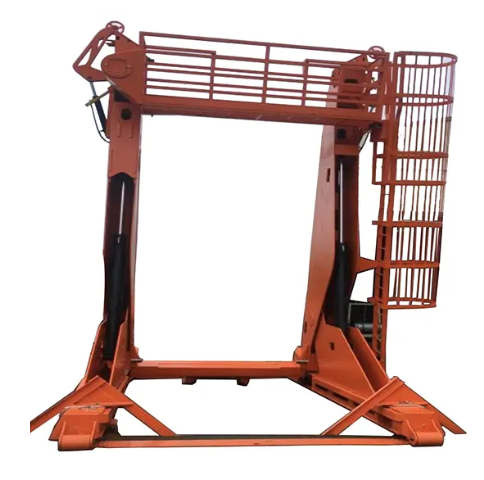Inefficient Space Utilization in Container Unloading
The Problem of Wasted Container Space
Poor container packing during unloading creates real money problems for shipping companies and manufacturers alike. Containers that aren't packed efficiently mean empty spaces where valuable products could be going, which translates directly into lost sales opportunities. The numbers tell a grim story too - the logistics sector loses millions every year because boxes aren't stacked properly inside those metal containers. Many warehouses still resort to slapdash packing methods that just make things worse. Take the common practice of putting big items down first. That usually leaves tiny nooks and crannies throughout the container that simply won't fit anything else. So either another container gets loaded, or shipments get delayed waiting for space. One major shipping firm actually tracked this problem over several months and found their operating expenses jumped while delivery schedules slipped behind schedule. Their bottom line took a hit, and customer satisfaction dropped accordingly.
Load Planning Software Solutions
Load planning software offers a way to get better at using space, which makes operations run smoother and saves money in the long run. The good stuff about these tools? They come packed with features like predicting what might happen next and running tests on how things fit together. This lets businesses figure out ahead of time where everything should go inside those shipping containers. Take it from companies already using such software - many report fewer headaches when packing loads because the system tells them exactly where to place items for maximum space usage. When shipments vary in size week to week, having predictions helps adjust quickly so no container goes underused. Getting this kind of software isn't just buying new tech; it changes how logistics teams think about space management altogether, turning what was once a frustrating problem into something that actually gives companies an edge over competitors.
Equipment Availability and Labor Challenges
Addressing Chassis and Machinery Shortages
Shortages of critical gear like chassis and machinery are causing major headaches across the logistics sector right now, mostly because of all those ongoing supply chain problems worldwide. A bunch of things have made matters worse too – higher transport demands, factory holdups, plus all sorts of international conflicts messing with normal operations. Some businesses are trying to work around this by teaming up directly with equipment makers for steady supplies, while others are looking at buying machines that can handle different kinds of jobs instead of specialized ones. Logistics insiders say the situation remains pretty tough out there. Containers sit waiting longer than usual at ports, and running costs keep climbing as companies struggle to get their hands on what they need. Good old fashioned planning about where and when equipment will be needed makes all the difference in keeping those containers moving efficiently through terminals without unnecessary delays.
Strategies for Workforce Management
Good workforce management makes all the difference when it comes to handling labor issues during container unloading operations. A solid plan helps keep workers busy where they're needed most, cuts down on wasted time, and speeds things up overall. When staff members get training for different jobs around the yard, they become much more flexible. This means one person can step in if someone else calls out sick or gets stuck somewhere else. Many terminals now use digital tools for scheduling shifts and tracking who's available when. These systems help managers know exactly who needs to be where without guessing games. Real world data shows ports that implement these methods see real results too - containers move faster through terminals, ships spend less time waiting, and workers generally feel better about their schedules. The bottom line? Putting together a comprehensive workforce strategy really does tackle those persistent labor problems at container terminals.
Weather-Related Disruptions in Unloading Operations
Impact of Adverse Weather Conditions
Bad weather including heavy downpours, thunderstorms, and strong gusts really messes up unloading work at seaports all the time. This causes massive delays and drives up expenses for everyone involved. When bad weather hits, operations often come to a complete stop because of safety issues. Equipment gets damaged too, sometimes even leading to dangerous situations on site. Take what happened back in Europe during that big storm last year for example. One important port had to shut down completely for two whole days. The company lost money left right and center while ships sat waiting offshore. Smart ports are starting to plan ahead though. Regular scheduling helps somewhat, but building better resilience into daily operations makes a bigger difference. If managers watch weather forecasts closely and have backup plans ready when storms approach, they can cut down both the hassle and cost of dealing with nature's surprises.
Implementing Weather-Controlled Facilities
Facilities that control weather conditions provide good way to keep operations running when bad weather hits. These places often have special tech like temperature controlled loading areas or covered spaces where goods can be unloaded safely, protecting everything from rain, snow or extreme heat. The setup helps things run smoother overall. Sure, setting up this kind of infrastructure costs money upfront, but it pays off in several ways. Safety gets better, there are fewer delays because work doesn't stop mid-process, and companies save cash by avoiding damage to cargo caused by unexpected storms. Look at what's happening in major ports around the world - Singapore has invested heavily in climate controlled terminals while Rotterdam has seen real gains after implementing similar systems. For any port looking to make sure ships unload properly no matter what Mother Nature throws at them, building out weather protected zones makes total sense both practically and financially.
Safety Risks During Container Unloading
Common Workplace Injuries in Port Operations
Port workers face real dangers on the job, especially when it comes to container unloading. The work itself is tough enough, but things get even worse when equipment breaks down or people make mistakes. Industry data shows most injuries at ports are sprains, strains, and broken bones from lifting heavy containers day after day. OSHA numbers back this up too they find that logistics workers get hurt more often than folks in other industries across the country. Faulty cranes and unreliable forklifts play a big role in these accidents, which means regular checkups and proper maintenance aren't optional they're essential. Looking at NIOSH research makes one thing clear: better training programs that tackle human errors head-on can cut down accident rates quite a bit. Ports that invest in worker education see fewer injuries overall.
Modern Safety Training Programs
Safety training has become really important for reducing dangers during container unloading operations. Good programs combine classroom teaching with hands on practice so workers actually learn what they need to know. Many now incorporate things like simulation exercises and cutting edge tech tools that help people get ready for what happens on the docks every day. Take VR simulations for example they let trainees experience realistic situations without any real danger. Some companies have seen great results from this approach. The Global Maritime Safety Training Initiative is one such program where ports saw about 30% fewer accidents after implementation. When organizations focus seriously on anticipating potential problems and teaching thorough safety protocols, it makes all the difference in creating workplaces where port staff feel protected while doing their jobs.
Technology-Driven Efficiency Improvements
Real-Time Dock Management Systems
Port operations have seen major improvements thanks to real time dock management systems. These systems help schedule things better and get resources where they need to be when needed, which cuts down on those frustrating bottlenecks and all that wasted time waiting around. The Internet of Things (IoT) is really making waves here too. Think about it this way: sensors attached to containers give constant updates on their location and condition while also showing how well different parts of the port are being used. Take Hamburg's port for example they saw their ship turnaround times drop by about 30% once they got one of these systems running. That kind of improvement speaks volumes about what these technologies can do for day to day operations at ports worldwide.
Automated Loading/Unloading Equipment
Bringing in automated loading and unloading gear has really shaken things up for logistics operations across the board. When ports start using robots alongside AI tech, they see their output go way up while spending less on staff wages. These machines handle container movements much faster than humans ever could, plus they make fewer mistakes because there's no fatigue factor involved. According to some research from the International Federation of Robotics folks, places that adopted these systems saw productivity jump around 25 percent over time. What this means practically is that shipping companies are now able to move goods through terminals at speeds previously thought impossible, which explains why we're seeing such dramatic changes throughout the entire supply chain network today.
FAQ Section
What are the main challenges in container unloading?
The main challenges in container unloading include inefficient space utilization, equipment shortages, labor management issues, weather-related disruptions, and safety risks.
How does load planning software help in optimizing container space?
Load planning software helps optimize container space by providing predictive analytics and simulations of load patterns, which forecast and plan the optimal arrangement of goods within containers, maximizing available space.
What solutions exist for adverse weather conditions affecting unloading operations?
Solutions for weather-related disruptions include implementing weather-controlled facilities like climate-controlled docks and covered unloading bays to protect cargo and equipment from adverse conditions.
How do automated systems enhance efficiency in container unloading?
Automated systems enhance efficiency by integrating robotics and AI technologies, expediting the unloading process, reducing human error, and boosting productivity.

